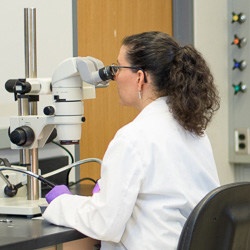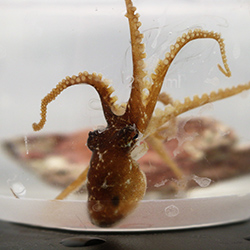Researchers Study Biology of Octopuses to Develop Autonomous Robots
An interdisciplinary team of researchers has received a $2,098,880 grant to study how the complex movements of octopuses can be used to design a bio-inspired, soft-armed, autonomous robot.
The team, consisting of a biologist, a material scientist and four engineers, received the grant, entitled “Octopus-Inspired Autonomous Arms for Soft Robots with Adaptive Motions,” from the Office of Naval Research.
“We want the robot to be adaptive to its environment,” Rebecca Fisher, PhD, said. “The octopus is a good model for this project, as their arms are capable of sensing local conditions and achieving some movements without input from the brain.”
 Dr. Fisher, an associate professor in the Department of Basic Medical Sciences and director of the Gross Anatomy Laboratory at the University of Arizona College of Medicine – Phoenix, is the biologist on the team. She received $316,000 to investigate the neuromuscular anatomy of octopus arms via Magnetic Resonance Imaging (MRI) and contrast-enhanced micro-Computed Tomography (micro-CT). Dr. Fisher will use the imaging core at the Barrow Neurological Institute to study the California two-spot octopus and the common octopus.
Dr. Fisher, an associate professor in the Department of Basic Medical Sciences and director of the Gross Anatomy Laboratory at the University of Arizona College of Medicine – Phoenix, is the biologist on the team. She received $316,000 to investigate the neuromuscular anatomy of octopus arms via Magnetic Resonance Imaging (MRI) and contrast-enhanced micro-Computed Tomography (micro-CT). Dr. Fisher will use the imaging core at the Barrow Neurological Institute to study the California two-spot octopus and the common octopus.
“As an anatomist, I am interested in form and function. How something is structured has specific effects on how that animal can move and how that animal can capture its prey. I see this project as a natural marriage between biology and robotics.”
In addition to her role at the UA College of Medicine – Phoenix, Dr. Fisher is an adjunct faculty member in the School of Life Sciences at Arizona State University. Her research laboratory is located on the ASU Tempe campus, which helped facilitate collaborations with ASU investigators, she said.
Dr. Fisher will be working with Daniel Aukes, PhD, an assistant professor of Engineering at ASU, and a specialist in design and rapid prototyping; Spring Berman, PhD, an assistant professor of Mechanical and Aerospace Engineering at ASU and a specialist in dynamics and control of bio-inspired robots; Hamid Marvi, PhD, an assistant professor of Mechanical and Aerospace Engineering at ASU and a bio-inspired roboticist; Matthew Peet, PhD, an associate professor in Mechanical and Aerospace Engineering at ASU and a specialist in control of partial differential equations and infinite-dimensional systems; and Ximin He, PhD, an assistant professor at the University of California, Los Angeles, and a material scientist with specialization in stimuli-responsive polymers and 3D-printing.

These methods will enable the researchers to visualize the complex 3D-organization of tissues throughout the arm, including major nerves, specific muscle layers and the suckers. The biological studies will inform the design of the distributed sensors, actuators and controls of the robotic arms.
“The goal is to design a bio-inspired robot, consisting of a mantle and multiple arms, that is capable of responding to local conditions and performing multiple tasks,” Dr. Fisher said. “Robots play many important roles in society today: in manufacturing, the military and health care. By studying animals that have amazing abilities, we can design more efficient and adaptive robots. It could really have an impact on people’s day-to-day lives. “
About the College
Founded in 2007, the University of Arizona College of Medicine – Phoenix inspires and trains exemplary physicians, scientists and leaders to advance its core missions in education, research, clinical care and service to communities across Arizona. The college’s strength lies in our collaborations and partnerships with clinical affiliates, community organizations and industry sponsors. With our primary affiliate, Banner Health, we are recognized as the premier academic medical center in Phoenix. As an anchor institution of the Phoenix Bioscience Core, the college is home to signature research programs in neurosciences, cardiopulmonary diseases, immunology, informatics and metabolism. These focus areas uniquely position us to drive biomedical research and bolster economic development in the region.
As an urban institution with strong roots in rural and tribal health, the college has graduated more than 1,000 physicians and matriculates 130 students each year. Greater than 60% of matriculating students are from Arizona and many continue training at our GME sponsored residency programs, ultimately pursuing local academic and community-based opportunities. While our traditional four-year program continues to thrive, we will launch our recently approved accelerated three-year medical student curriculum with exclusive focus on primary care. This program is designed to further enhance workforce retention needs across Arizona.
The college has embarked on our strategic plan for 2025 to 2030. Learn more.